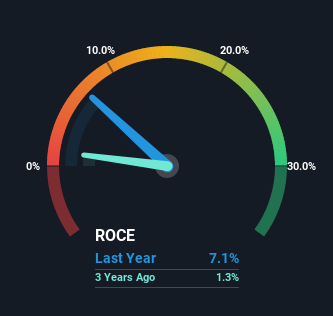- India
- /
- Renewable Energy
- /
- NSEI:RTNPOWER
RattanIndia Power (NSE:RTNPOWER) Is Looking To Continue Growing Its Returns On Capital
If we want to find a potential multi-bagger, often there are underlying trends that can provide clues. One common approach is to try and find a company with returns on capital employed (ROCE) that are increasing, in conjunction with a growing amount of capital employed. This shows us that it's a compounding machine, able to continually reinvest its earnings back into the business and generate higher returns. Speaking of which, we noticed some great changes in RattanIndia Power's (NSE:RTNPOWER) returns on capital, so let's have a look.
Return On Capital Employed (ROCE): What is it?
For those who don't know, ROCE is a measure of a company's yearly pre-tax profit (its return), relative to the capital employed in the business. To calculate this metric for RattanIndia Power, this is the formula:
Return on Capital Employed = Earnings Before Interest and Tax (EBIT) ÷ (Total Assets - Current Liabilities)
0.071 = ₹3.9b ÷ (₹177b - ₹122b) (Based on the trailing twelve months to March 2022).
So, RattanIndia Power has an ROCE of 7.1%. On its own that's a low return on capital but it's in line with the industry's average returns of 7.2%.
Check out our latest analysis for RattanIndia Power

While the past is not representative of the future, it can be helpful to know how a company has performed historically, which is why we have this chart above. If you're interested in investigating RattanIndia Power's past further, check out this free graph of past earnings, revenue and cash flow.
How Are Returns Trending?
We're pretty happy with how the ROCE has been trending at RattanIndia Power. The figures show that over the last five years, returns on capital have grown by 162%. That's not bad because this tells for every dollar invested (capital employed), the company is increasing the amount earned from that dollar. In regards to capital employed, RattanIndia Power appears to been achieving more with less, since the business is using 68% less capital to run its operation. If this trend continues, the business might be getting more efficient but it's shrinking in terms of total assets.
For the record though, there was a noticeable increase in the company's current liabilities over the period, so we would attribute some of the ROCE growth to that. Essentially the business now has suppliers or short-term creditors funding about 69% of its operations, which isn't ideal. Given it's pretty high ratio, we'd remind investors that having current liabilities at those levels can bring about some risks in certain businesses.
The Key Takeaway
In a nutshell, we're pleased to see that RattanIndia Power has been able to generate higher returns from less capital. And since the stock has fallen 47% over the last five years, there might be an opportunity here. With that in mind, we believe the promising trends warrant this stock for further investigation.
RattanIndia Power does have some risks, we noticed 2 warning signs (and 1 which makes us a bit uncomfortable) we think you should know about.
While RattanIndia Power may not currently earn the highest returns, we've compiled a list of companies that currently earn more than 25% return on equity. Check out this free list here.
New: AI Stock Screener & Alerts
Our new AI Stock Screener scans the market every day to uncover opportunities.
• Dividend Powerhouses (3%+ Yield)
• Undervalued Small Caps with Insider Buying
• High growth Tech and AI Companies
Or build your own from over 50 metrics.
Have feedback on this article? Concerned about the content? Get in touch with us directly. Alternatively, email editorial-team (at) simplywallst.com.
This article by Simply Wall St is general in nature. We provide commentary based on historical data and analyst forecasts only using an unbiased methodology and our articles are not intended to be financial advice. It does not constitute a recommendation to buy or sell any stock, and does not take account of your objectives, or your financial situation. We aim to bring you long-term focused analysis driven by fundamental data. Note that our analysis may not factor in the latest price-sensitive company announcements or qualitative material. Simply Wall St has no position in any stocks mentioned.
About NSEI:RTNPOWER
RattanIndia Power
Together with its subsidiary, Poena Power Development Limited, engages in power generation, distribution, trading and transmission, and other ancillary and incidental activities in India.
Questionable track record with imperfect balance sheet.
Market Insights
Community Narratives



